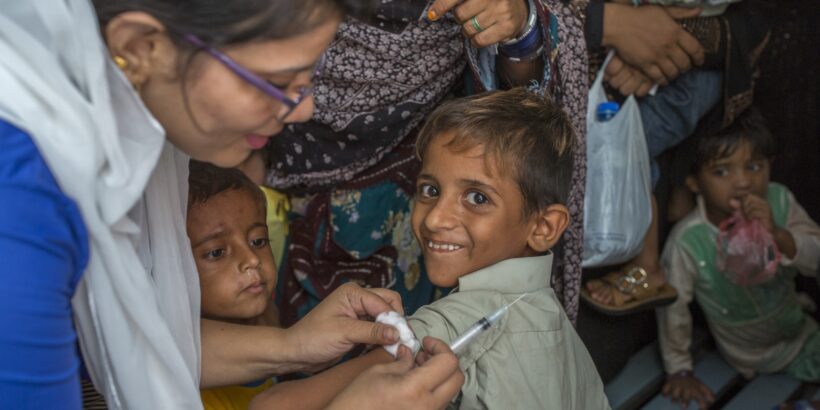In 2019, Pakistan made history as the first country to introduce typhoid conjugate vaccines (TCV) into its routine childhood immunization program. Six years later, the country has vaccinated more than 30 million children through TCV campaigns and reaches millions more through routine immunization. Pakistan continues to lead the way in the prevention and control of typhoid with its commitment to disease surveillance alongside the routine vaccination program.
The importance of typhoid surveillance in Pakistan
Ongoing typhoid surveillance is essential after TCV introduction. Disease surveillance enables health officials to track a vaccine’s long-term effectiveness and identify emerging trends or drug resistance patterns. Continuous monitoring also ensures that typhoid cases can be detected and addressed, preventing large-scale outbreaks.
Prevention measures are critical in Pakistan, where severe flooding in recent years has damaged water systems and raised the risk of waterborne diseases like typhoid. Pakistan also has one of the highest rates of drug-resistant typhoid, with more than 15,000 cases of extensively drug-resistant (XDR) typhoid officially recorded. These cases do not respond to first-line antibiotics, which are cheaper and more readily available. Instead, XDR cases are treated with second- and third-line antibiotics, which are more expensive and more difficult to access.
Pakistan’s typhoid surveillance efforts
In the face of these challenges, Pakistan’s Federal Directorate of Immunization (FDI) and other partners continue to make typhoid surveillance a central priority.
“FDI’s work to improve typhoid surveillance underscores the country’s deep commitment to protect every child from the disease. Long-term, high-quality data enable decision-makers to better understand the scale and impact of typhoid and determine where to assign limited resources,” said Dr. Soofia Yunus, Director General, FDI, Ministry of National Health Services Regulations and Coordination.
Before TCV introduction, there were nine sites for typhoid surveillance across the country. Today, there are 22 surveillance sites, made functional by technical support from the World Health Organization (WHO) with funding from Gavi, the Vaccine Alliance. The objectives of these surveillance sites include describing typhoid epidemiology, measuring the outcomes of TCV introduction, and estimating the proportion of XDR typhoid. Pakistan’s Expanded Program on Immunization (EPI) incorporated TCV into the routine schedule in phases from 2019 to 2022.
“Accurate data is critical for program monitoring,” said Dr. Sunday Audu, Technical Officer-VPD Surveillance, WHO, Pakistan Country Office. “The sentinel sites were established to generate high-quality data to estimate the magnitude of typhoid, including XDR. An active approach requires the review of laboratory records to identify confirmed cases, including XDR.”
According to Dr. Audu, since 2023 there has been a sustained decline in the number of confirmed typhoid cases from the sentinel sites.
In November 2024, FDI and EPI Pakistan partnered with WHO to hold the Annual Sentinel Sites Surveillance Review of nine teaching hospitals that track typhoid and other diseases. The annual review offered the provincial technical team an opportunity to meet with designated officials from teaching hospitals, identify roadblocks in disease surveillance efforts, and discuss solutions to these challenges.
EPI Pakistan and WHO also held a Typhoid Sentinel Surveillance Training in Islamabad, which focused on comprehensive data collection for typhoid. The training covered patient demographics, risk factors, screening tests, lab investigations, immunization, treatment, and follow-up, with the goal of ensuring high data quality and accuracy.
“Compared to 2019, before the TCV campaign, we’ve seen a remarkable drop in typhoid cases in Karachi,” said Dr. Khalid Shafi, Chairperson of the National Immunization Technical Advisory Group (NITAG). “For two years after the campaign, cases remained low — and most infections occurred in children who missed their vaccine dose.”
Informing the future of typhoid prevention
“Before TCV, our pediatric wards were overwhelmed with XDR typhoid cases, and the cost of treatment was extremely high,” added Dr. Shafi. “Now, while typhoid remains endemic, the majority of cases are among unvaccinated children, with occasional breakthrough cases. If we raise TCV coverage at 9 months to over 90 percent, we can control it even further. But this must go hand in hand with safe water, proper sanitation, and food hygiene.”
As rates of drug-resistant typhoid continue to rise, Pakistan’s surveillance efforts will be essential to inform future immunization campaigns. In the words of Dr. Shafi, disease surveillance must go hand in hand with improvements in water, sanitation, and hygiene, informed treatment guidelines, and other solutions.
Cover photo: Nine-year-old Qadir Buksh receives the typhoid conjugate vaccine during a 2018
vaccination campaign in Kharadar General Hospital in Karachi, Pakistan. Credit: PATH/Asim Hafeez.



